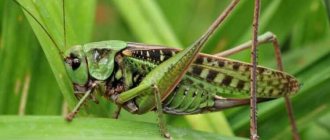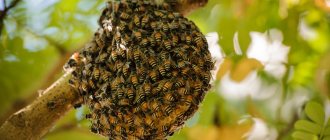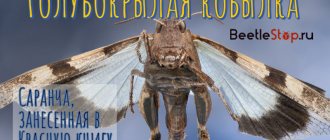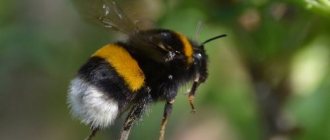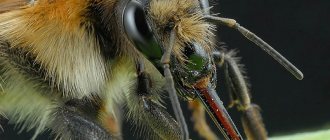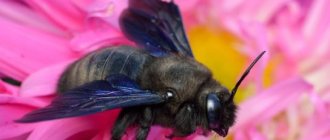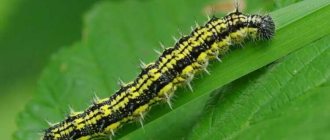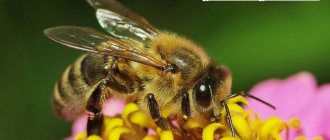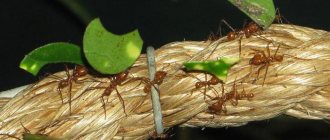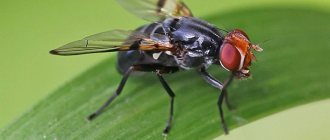Description
Bumblebees belong to the class of arthropod winged insects and are a type of bee. The original name of the genus in Latin is “Bombus”. Creatures are widespread on Earth, living in all corners of the planet where there are suitable living conditions. Now zoologists know about 300 different varieties of insects, which belong to fifty subspecies.
The two most common types of bumblebees are Bombus terrestris and Bombus lapidarius. They live in most countries.
Back view of bumblebee
You can distinguish a bumblebee from other bees by its large size and rounded contours of its body. Thanks to the hairs on their body, they adapt well to cold climates and do not freeze. They are also considered warm-blooded insects. When moving quickly, their body begins to generate heat, and the internal temperature can reach forty degrees.
People have a stereotype that a bumblebee bite is very painful, and in general it is better to beware of insects. Such fears arose due to the large size of the creature and powerful jaws. However, in fact, this type of bee is the most peaceful and harmless.
Interesting fact : the sting of a bumblebee is smooth and does not have serrations, unlike a bee's. If the latter retains it in the victim, then the bumblebee, having made a bite, can pull it back into the body and fly away.
Bumblebees never attack first. They do not use their jaws as weapons, despite their power, and their only defense is their stinger. But the individual will use it if there is no other way out. Moreover, only females and insects that build a hive have it. Ordinary males do not have a sting and are almost completely defenseless. In nature, the bumblebee brings great benefits by pollinating a large number of flowers.
Preventing the appearance of a bumblebee nest on the site
To kill the problem in the bud, many summer residents resort to the following method. Water is poured into a bucket, sugar, soap solution and vinegar are added. The container is placed in places where bumblebees have been spotted. Sweetness will attract them, soap will not allow them to fly into the air, and vinegar will poison them. It is better to repeat the procedure several times over the summer. You can make several baits if the area is large and place them around the entire perimeter. Kerosene, gasoline, and bleach also have a detrimental effect on bumblebees.
To prevent bumblebees from daring to return to the old place, it is advisable to repaint it in a dull color and introduce a new detail into the interior. You can hang an artificial bee nest: bumblebees will never settle next to their relatives.
If, after getting rid of one nest, a new one soon appears, this means that the place is popular with bumblebees. It is better to accept their proximity: if you do not disturb them, they do not cause trouble.
Embedded video
Sources
- https://GdeKlop.ru/osy-i-pchely/sredstva-istrebleniya-shmelej/
- https://glav-dacha.ru/dlya-chego-nuzhen-shmelinyy-uley/
- https://DomPchel.ru/pchelovodstvo/poleznoe/shmeli/
- https://felisov.ru/osy/kak-izbavitsya-ot-shmelej.html
- https://7ogorod.ru/prochee/kak-izbavitsa-ot-smelej.html
- https://med-post.ru/dom/kak-vyvesti-shmeley
- https://apest.ru/nasekomye/shmeli/kak-izbavitsya-ot-shmelej/
- https://nzs-rst.ru/mol/kak-vyvesti-shmelej.html
Appearance and features
Yellow pollen on the black stripes of a bumblebee
The bumblebee has a massive body compared to other representatives of bees. Impressive dimensions are achieved due to developed pectoral muscles. They also serve as an additional source of heat along with the fluff. In cool weather, the insect begins to intensively contract its muscles, thereby increasing body temperature. This helps to warm up the body and go to pollinate flowers earlier than other types of bees.
On the sides of the body there are three pairs of limbs: two small legs in front and four large ones coming from the center. Bumblebees fly thanks to two wings located on the front of the body.
Bumblebees are black in color, with two yellow stripes on top: at the head and under the wings. There is also a white stripe in the sting area. The entire body is covered with small hairs, which determine the color pattern.
The head is quite small in relation to the body. At the top there are two long antennae planted next to the eyes. In front there is a powerful jaw, inside of which a long tongue is hidden.
Depending on the type, the insect can be of different sizes. Steppe bumblebees are the largest and can grow up to 3.5 cm in length. In common species, males reach up to 2.5 cm. Females are larger: their length reaches 2.9 cm. The body weight of males does not exceed 0.6 g , but for women it often exceeds 0.8 g.
Sexual differences, reproduction
Sexual dimorphism is expressed implicitly. The sizes of females and males differ little. Features of female and male individuals relate to the appearance and structure of the body. Examples:
- the head of females is elongated, and that of males is round or triangular;
- males have a powerful mouthparts, while females have a rectangular upper lip and curved mandibles;
- in females, the abdomen ends in a smooth, multi-acting sting, and in males, instead of a stinger, the genitals are covered with a layer of chitin;
- On the hind legs of females there is a “basket”, that is, a place surrounded by hairs for collecting pollen grains.
Bumblebees reproduce through complete metamorphosis in nature. Insects go through 4 stages of development: egg, larva, pupa and adult. Fertilization of the uterus in the family occurs in the fall. Life cycle:
- Preparation for nesting - the fertilized queen flies out in the spring after wintering and looks for a suitable place.
- Set up the nest over a period of several weeks and place a wax bowl with nectar at the entrance.
- Laying elongated eggs of 8–16 pieces - before this, the queen creates a cushion of pollen and beebread, covered with wax, in the middle of the nest.
- The larvae emerge in 4–6 days - they stretch and break through the wax shell, and the female and her toilers constantly repair this layer.
- Pupation after 1.5–3 weeks - the larvae weave a cocoon, and the queen again creates an accumulation of pollen with beebread and lays another dozen eggs.
- Emerging from the cocoons after 10–19 days - the young animals gnaw through the shell; the empty cells are not disposed of in the family, but are left for storing honey.
The first offspring appears after 3–4 weeks. The emerging young become working bumblebees. They take on the responsibilities of the queen, while the female stops leaving the nest, but only lays eggs and helps feed the larvae. Insects do not use cells twice to rear brood, but build new devices each time.
Where does the bumblebee live?
Bumblebee habitat
Due to their good adaptation to environmental conditions, bumblebees live in almost all corners of the planet. Exceptions are places where there is very little vegetation, as well as in hot climates. At high temperatures, the insect begins to feel uncomfortable due to the fact that its body already generates a lot of heat during activities.
In some places the number of bumblebees is small. For example, the Arctic Circle is home to small populations of individual species adapted to cold climates and capable of pollinating local vegetation. In Greenland, Alaska and Chukotka they can only be found in alpine meadows. Small populations also occur in lands with a tropical climate.
Interesting fact : in some countries, gardeners specially breed garden bumblebees to increase productivity.
Most species of bumblebees live in Russia, Europe, Asia and America. They enjoy the local climate and abundant vegetation. Not so long ago, insects were specially brought to Australia, to the state of Tasmania. There they are used to increase the yield of clover, and bumblebees cope with their task with five points. And their peacefulness simplifies the process of using them.
Habitat and lifestyle of bumblebees
Bumblebees settle where the plants they are interested in grow
Since several hundred species of bumblebees live on Earth, each has certain characteristics depending on environmental conditions and habits.
Bombus terrestris lives in Africa. It is black in color with small white spots on its belly. These bumblebees build their hives in the ground; this is done by the workers.
Bombus lapidarius is common in Europe. On its black body there are red-orange stripes, by which it is easy to distinguish it from other representatives of bees. If the African type of insects grows up to three centimeters, then this one is usually no more than two in length. They build their nests on rocks. This species is also characterized by cannibalism: females often feed males to their larvae.
A bumblebee collects pollen and nectar using its proboscis
Regardless of the species, bumblebees live in flocks and have a clear division into roles: queen, males and workers. The queen actively participates in the life of the nest and gives birth to offspring. Males and workers are engaged in approximately the same activities, but the former pay more attention to pollinating flowers, the latter - to expanding and strengthening the house. While bees try to carefully design the nest, planning entrances and internal structure, bumblebees often neglect this. Their houses look shapeless, as if they were made in haste. The material used is fur and wax, which are simply piled up and tunnels are dug inside.
Interesting fact : in order not to build a nest, bumblebees can occupy a mouse hole, driving out the previous occupant.
Bumblebees are very hardworking and go out every day to pollinate flowers. At the beginning of the day, the queen climbs onto the roof of the nest and begins to make loud sounds, thereby awakening all members of the flock from sleep. Having woken up, the insects go to work.
Installation
To prevent raindrops from flowing into the tap-hole tube, when installing it, you must tilt it with the tap-hole end down. Lubricate the outer and inner ends for a length of 55 mm with charcoal to resemble a mouse hole; the entrance should be dark in color.
Three hives can be placed underground; the entrance to the house will be a 100 cm long tube made of 10 mm slats. The hole should be 20x20 mm, it must be tightly attached to the tap hole.
To install the bumblebee house, you need to cover the ground with a shovel and put it aside. The hole should be cubic in shape, and place the box there. Make a hole in the turf for a tube the size of an orange and attach it to the tap hole. Carefully coat the cracks with clay to prevent ant attacks. Cover the top of the bumblebee with an additional layer of earth and cover it with turf.
Features of the location of the hive
Bumblebees build their hives in different ways. They can be located both underground, above and on it.
Hive underground
Most insects of this species locate their nests underground. They use rodent and mole holes for housing. It is the smell of mice that attracts female bumblebees. In such a nest there is always material for insulation: wool, grass, and so on.
There is a list of insect species that prefer to make nests underground:
- Garden;
- Large earthen;
- Stone;
- Norny;
- Underground;
- Motley.
Nests on the ground
Some types of bumblebees choose objects on the surface of the earth to build their nests. They build their homes on the ground. To build hives, all available materials are used: hay, straw, grass, dry land, remains of abandoned bird nests.
Nest on the ground
Prominent representatives who build their hives on the ground are:
- Field;
- Mozovoy;
- Forest;
- Schrenk;
- Lugovoy.
Nests above ground
There are several varieties of bumblebees that build their nests in burrows, hollows, birdhouses, and under roofs. These species include the urban bumblebee, jonellus, and hollow.
Also in nature, there are several types of insects that can build hives, both above and in the ground.
Building hives
How long do rabbits live?
The shape of the hives in and above the ground that bumblebees create depends on the cavity where they are located. Ground nests are most often made in the shape of a sphere. Dry moss, grass and wax are used for insulation and strengthening. The latter is a product of the vital activity of the insects themselves. Wax is produced by special glands on the abdomen. Thin strips of wax are formed on it, which the insect chews in its mouth until pliable. Already with a soft plastic material you can do whatever you want. The founder of the family secretes the wax first, then the working individuals take on this role. The result is a wax dome that protects the bumblebee nest from moisture penetration. The entrance is masked in a similar way so that enemies or cuckoo bumblebees do not get inside.
Interesting fact. The air temperature in the hive is maintained within 30-35 degrees. If the temperature increases, insects create artificial ventilation by flapping their wings at the entrance.
What does a bumblebee eat?
Clover is the favorite treat of bumblebees
Perhaps these creatures are the most finicky of the bee order in terms of food. If wasps can eat jam, honey, tree sap and other sweets, then bumblebees have only pollen and nectar in their diet. However, the list of plants from which they collect food is very long. They pollinate almost all flowers that grow in their habitats. It is often used in gardening. If a beehive has appeared next to the garden, there is no doubt that in the near future there will be a large harvest in the garden beds.
The larvae also need food, so upon returning to the nest, individuals try to bring as much nectar as possible, which serves as food for future offspring. If necessary, the cubs are also fed home-produced honey.
The bumblebee's favorite flower is clover. He is attracted by the smell and color of the plant, and as he flies past he cannot resist. It has also been noticed that bumblebees, just like other bees, are more willing to sit on bright buds than on those that have faded colors. However, if there is no other vegetation nearby, the insect will not hesitate to land on them.
Origin of the species
The first species of bumblebees appeared millions of years ago
Scientists believe that bumblebees appeared about 30 million years ago, during the Oligocene period. But the found remains of insects from that time are poorly preserved, and the data obtained during the study is not enough to prove their belonging to this species.
Interesting fact : Most insects of the past are studied based on species found in tree resin. But bumblebees, due to their large size, do not fit in a drop of sticky substance, so finding their fossils is a great success.
The oldest insect remains that are definitely bumblebees date back to the Miocene and are approximately 20 million years old. It is believed that this species of bees originated in Asia, from where it gradually moved to Europe. After some time he reached America.
Over the past two centuries, a dozen remains of bumblebees have been discovered, which are from 10 to 20 million years old. Moreover, discoveries were made all over the world, on different continents.
Interesting Facts
Bumblebees are very interesting insects. Biologists, observing them, noticed many interesting facts:
- On hot days you can often see bumblebees fluttering their wings. In a similar way, they arrange artificial ventilation to reduce the temperature in the home.
- Today there is a separate branch of agriculture - bumblebee farming. Insects are bred to speed up the natural pollination processes of crops.
- Bumblebee venom does not cause as much harm to humans as bee venom, since the sting does not remain inside. But an insect can sting many times.
- While moving, representatives of these insects reach speeds of up to 18 km/h.
- Before wintering, the female can independently dig a hole for herself in order to overwinter, but in the spring, when the time comes to create a nest, she forgets about her ability and looks for ready-made shelters to create a hive.
Bumblebees are very hardworking insects that are constantly on the move. Throughout the season, they build a new home in order to give life to a new generation at the end of the year, then die themselves. Few people manage to live such a short period and do so many things.
4.8 4 votes
Article rating
The difference between a bumblebee and a hornet, who is stronger?
There are other representatives of striped individuals in the bee family. People sometimes confuse them, believing, for example, that a hornet and a bumblebee are one and the same. Although they even have external differences.
Hornet
Note! Despite the fact that the hornet is a large individual (up to 5 mm long), in appearance it is more similar to a wasp, but does not have such a narrow waist. The insect’s body also lacks a fur coat.
The two representatives of the family also differ in their disposition. Bumblebees are peace-loving creatures and attack only as a last resort. Hornets are aggressive and don't even need a reason to sting. At the same time, the bite is painful and much more poisonous than that of a bumblebee.
Hornets, like wasps, do not produce honey, but actively attack hives. At the same time, they do not hesitate to feast on the bees themselves, gnawing off their heads. Aggressors also feed on other insects and can even attack small animals.
Hornets try not to fight bumblebees, knowing that they will receive a worthy rebuff. Although hairy insects are inferior in strength to pests.
Paleontology
Fossil bumblebee †Bombus cerdanyensis Dehon et al., 2014 (~10 Ma, Miocene, Spain)
Fossil bumblebee †Bombus trophonius (Miocene, Czech Republic)
The earliest reliable fossils of the genus Bombus
dated back to the Miocene (20-10 million years). Earlier finds are also known, but they are not described in sufficient detail, for example, dated to the Oligocene (33-23 million years) and the Eocene (Florissant USA, 37-33 million years), so their assignment to bumblebees is conditional and the time of origin of the group is still unknown. The bumblebee fossil is a very rare find because it is very difficult for such a large insect to become encased in resin and become completely encased in it to harden in amber. The findings indicate that Asia was where bumblebees first appeared, and this part of the world is still home to the greatest diversity of bumblebees. They probably spread to western Asia, through Europe to North America, and eventually to South America.
- †Bombus vetustus Rasnitsyn & Michener, 1991 (10 Ma, Miocene, Russia)
- †Bombus abavus Heer, 1867 (Miocene, Germany)
- †Bombus anacolus Zhang et al., 1994 (15 Ma, Miocene, China)
- †Bombus cerdanyensis Dehon et al., 2014 (10 Ma, Miocene, Spain)
- †Bombus coironensis Riou, 1999 (Miocene, France)
- †Bombus crassipes Novák, 1878 (16 Ma, Miocene, Czech Republic)
- †Bombus dilectus Zhang et al., 1994 (15 Ma, Miocene, China)
- ?†Bombus florissantensis (Cockerell, 1906) (37–33 Ma, Eocene, USA)
- = Calyptapis florissantensis Cockerell, 1906
- †Bombus luianus Zhang, 1990 (15 Ma, Miocene, China)
- ?†Bombus pristinus Rogenhofer, 1867 (20 Ma, Miocene, Greece)
- †Bombus proavus Cockerell, 1931 (15 Ma, Miocene, USA)
- †Bombus randeckensis Wappler & Engel, 2012 (10 Ma, Miocene, Germany)
- † Bombus trophonius
(subgenus
Cullumanobombus
) (Miocene, Czech Republic)
Literature[edit | edit code]
- Bumblebees // Encyclopedic Dictionary of Brockhaus and Efron: in 86 volumes (82 volumes and 4 additional). - St. Petersburg, 1890-1907.
- Key to insects of the Russian Far East. T. IV. Reticuloptera, Scorpioptera, Hymenoptera. Part 1 / under general ed. P. A. Lera. - St. Petersburg: Nauka, 1995. - P. 552-553. — 606 p. — 3150 copies. — ISBN 5-02-025944-6.
- Charles Duncan Michener (2000). The Bees of the World
. Johns Hopkins University Press. - “Bees.” World Book Encyclopedia 1998 ed.
- Hasley, William D. “Bees.” Collier's Encyclopedia 1990 ed.
- Freeman, Scott. Biological Science. New Jersey: Upper Saddle River, 2002.
- Abbott, Carl, and Bartlett, John. "Bumble Bees" Encarta Encyclopedia. 2004 ed.
- Goulson, Dave. “Bumblebees: Their Behavior and Ecology” 2003. Oxford University Press ISBN 0-19-852607-5
- Macdonald, M. & Nisbet, G. 2006. “Highland Bumblebees: Distribution, Ecology and Conservation.” HBRG, Inverness, hbrg.org.uk. ISBN 0-9552211-0-2.
- Schweitzer, Dale F. et al. (2012). Conservation and Management of North American Bumble Bees
. Washington DC: US Forest Service.
Breeding bumblebees at home
Parcel with bumblebees
Bumblebees are very useful in gardening, so many summer residents decide to breed them. As a rule, about 50 individuals from one family move into a pre-prepared nest. This ensures that they get along well with each other, distribute roles and begin pollinating plants.
If settlement is successful, the queen quickly begins to produce new offspring, and the workers begin to establish the economy. Before the onset of cold weather, the owner needs to thoroughly fatten the female so that she survives the winter.
Aerodynamic characteristics
Bumblebee in flight
For a long time it was believed that bumblebees could fly, contrary to the laws of physics. Indeed, a massive body carried on one pair of small wings is quite an unusual sight. However, physicist Jane Wang from a US university was able to prove that there is nothing surprising in the flight of a bumblebee.
The scientist spent several hours simulating the passage of dense wind currents through the moving wings of an insect and found that this process fully complies with the laws of physics.
Bumblebee protection
Most bumblebee species do not need protection
Since there are several hundred species of bumblebees on the planet, it is not surprising that some of them are on the verge of extinction and are listed in the Red Book. There are several reasons for the population decline: deteriorating environmental conditions, lack of sufficient food, enemies who have settled nearby, etc.
Interesting fact : some species of bumblebees are gradually disappearing because the types of plants suitable for them have disappeared in their habitats, and they fundamentally do not want to switch to others.
At the moment, people are not taking any measures to protect bumblebees. This is due to the fact that, along with endangered species, there are also those that, on the contrary, are increasing their populations. Due to them, the bumblebee family as a whole does not die out, which is the main argument not to take any measures.
Taxonomy
Classification
Main article: List of bumblebee species
There are about 300 species of bumblebees from about 50 subgenera known in the world. Psithyrus cuckoo bumblebees
sometimes previously considered a separate genus, but more recently they have been included in
Bombus
(in one or more subgenera), and the total number of subgenera is reduced to 15, which are considered monophyletic, diagnosed by morphology, behavior and ecology.
| Bombus | ||||
|

